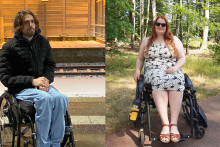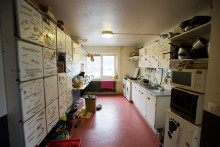Dominik Weidenhöfer (21) is an exchange student from Germany. He became disabled at 15 after a snowboard accident, leaving him in a wheelchair. When asked whether special arrangements were made prior to his arrival, he said he was adequately advised by UT’s housing organization De Veste and soon got a room on campus.
How accessible is the campus, according to him? ‘I’d say most of the campus is accessible. Sometimes it’s a bit difficult and complicated to reach certain rooms. I’m used to a worse environment; here on campus it’s actually alright. There is an access to almost every room and labelled bathroom. So, it’s okay.’
‘It’s all about the level of inconvenience’
Yet, for a student from previous years the experience is different. In 2020, Anouk Noordeloos (27), a UT student currently working on her master assignment on Disability & Design, already spoke out about how hard it is to get around campus as a disabled person. She stressed struggling with accessing bathroom facilities and covid-19 rules that wouldn’t allow for certain classes to be held remotely and how this impacted her education.
She wrote a letter to the UT Executive Board, which was also covered by U-Today. What has changed since then? ‘I haven't noticed any changes to the physical accessibility of the university campus. The only change I've noticed is in terms of awareness.’ Noordeloos still faces the same difficulties. However, she remains actively involved in the UT’s efforts to be more accessible.
'At my previous university I couldn’t access a room I had my exam in, and it was horrible. Here I think the situation is quite good' - Dominik Weidenhöfer
While Noordeloos sees no major change since 2020, Weidenhöfer finds that the level of accessibility is still satisfactory. The difference lies in the perception, he says. ‘It’s about the level of inconvenience you feel about and how difficult you find it to use elevators or ramps. For me the campus is accessible for the most part, possibly because I was used to a worse environment in this regard. At my previous university I couldn’t access a room I had my exam in, and it was horrible. Here I think the situation is quite good.’
The role of design
As a student of Industrial Design Engineering, Noordeloos says that design is important in promoting accessibility. However, she highlights that the process should be more user oriented. ‘Design plays a big role in physical accessibility of space, but the design process must include consulting the end users of your design, especially if they are different from the designer. It's easy to design for yourself, but much harder to imagine what someone very different from yourself would need.’
'Talk to your users and find out what they need to move through and exist comfortably in the spaces you design' - Anouk Noordeloos
She emphasizes the ambiguity of design by reminding that following accessibility guidelines is not sufficient: ‘Talk to your users and find out what they need to move through and exist comfortably in the spaces you design. The official accessibility guidelines are just a starting point.’
Weidenhöfer says most of the campus is accessible thanks to its design. He thinks design plays an important role in both ‘enabling’ and ‘possibly enabling’ accessibility. ‘The design of the building makes it both easier and harder at times. For example, I don’t like sitting in front of the class all the time, due to narrow backrows in classrooms and the library. On a positive note, the entrances are barrier free and low, which make most of campus facilities accessible.’
So far, official accessibility guidelines make it possible for Weidenhöfer to access ‘almost’ every room. Nevertheless, he says that ‘almost’ can sometimes make a big difference. He finds that design and placement of elevators in certain buildings make getting to class on time difficult, which can be frustrating. ‘Sometimes it takes a bit longer, depending on the building. In Carré it takes much longer than when you take the stairs. If I’m late to class, I will be even later because of the time it takes to go around. It’s still better than what I was used to in my bachelors.’
The power of policy makers
Weidenhöfer agrees that designers play a crucial role in promoting accessibility. However, he feels that the responsibility of making the campus accessible lies with policy makers, not with designers. ‘I believe policy makers are more responsible because they have more power. If the government forces policies that make universities more accessible, then the UT must do it. But it’s also a decision of the UT themselves to be more inclusive, diverse, and accessible.’
'It’s not that you have special needs, it’s that your basic needs need to be fulfilled by certain architectural adjustments' - Dominik Weidenhöfer
The UT is not fully ignorant to these matters. Noordeloos mentions she met other disabled students through UT organised events and that they share a somewhat common perspective: ‘I've also met other disabled people through events during Diversity Week, The Diversity Equity and Inclusion group at UT, and the signing of The UN declaration of Studying with a Disability. Many of my views written in the letter to the UT board were shared by these fellow disabled students.’
Wheelchair-friendly Waaier 4
Recently, the UT renovated the Waaier 4 lecture hall, to make it more accessible for disabled people. The hall is primarily used for promotion ceremonies and now includes a wheelchair lift. The first promotion ceremony in this new layout took place in February 2023.
Where to improve?
Noordeloos still challenges the distinction between raising awareness and taking proper action. She started a petition in 2020, hoping to spread this issue to a wider audience. ‘My petition has led to more awareness, and I've been asked to give input from my perspective on physical accessibility of designs at UT, but often at a late stage of the design process. So, not many things can be changed at that point.’
What suggestions would they give designers and policy makers to improve their situation? ‘If I had to say, the priority would be adding more accessible bathrooms. I would also appreciate wider classrooms and elevators closer to lecture halls’, says Weidenhöfer. ‘Sometimes I have to go to another floor’s bathroom, which takes a while. It’s not that because you are disabled you have special needs, it’s that your basic needs need to be fulfilled by certain architectural adjustments.’







